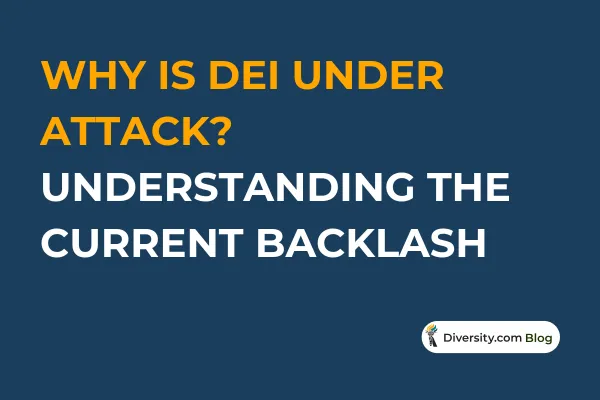
Why Is DEI Under Attack? Understanding the Current Backlash
Diversity, Equity, and Inclusion (DEI) programs have become one of the most polarizing topics in the United States.
While many organizations still support DEI efforts, 2025 has seen an increase in legal challenges, political pushback, and public skepticism.
The term itself is now at the center of heated debates about fairness, merit, and identity.
To understand why DEI is under attack, we need to explore the sources of this backlash.
What changed in the political and legal landscape?
Why are some companies retreating?
And what are the larger societal narratives influencing how people view inclusion today?
The Legal Landscape: DEI After the Supreme Court's Affirmative Action Ruling
In June 2023, the U.S. Supreme Court ruled in Students for Fair Admissions v. Harvard that race-conscious admissions policies in higher education violated the Equal Protection Clause. Though the ruling focused on universities, its ripple effects have reached businesses and government agencies.
Key consequences:
Increased scrutiny of race-based programs and hiring goals
Legal ambiguity around how companies track and report diversity data
Lawsuits against companies that maintained demographic-specific programs
Several states have since introduced or passed laws restricting DEI training or removing DEI offices in public institutions.
Political Polarization and State-Level Bans
In some states, DEI has become a political flashpoint. Governors in Florida, Texas, and other states have enacted laws to:
Ban mandatory DEI training in universities
Remove DEI offices from state-funded institutions
Limit funding for diversity-related programs
These moves are often framed as promoting individual merit, viewpoint diversity, or "freedom from ideological training."
At the same time, many educators, students, and civil rights groups argue that these laws suppress conversations about race, gender, and inequality in the name of neutrality.
Corporate Caution and Retraction
Some companies, especially those with government contracts or conservative stakeholders, have responded by scaling back DEI programs.
Examples include:
Accenture ending formal DEI targets in early 2025
Zoom disbanding its internal DEI team
Meta and Ford rebranding DEI offices as "employee engagement" or "people experience"
In many cases, companies cite regulatory uncertainty or reputational risk. They are not abandoning inclusion entirely, but they are adjusting how they talk about it.
Public Misconceptions and Fatigue
Part of the backlash comes from misunderstanding what DEI is and is not.
Common misconceptions:
DEI is only about race or gender
DEI means hiring unqualified candidates
DEI excludes men or white employees
Add to this a sense of fatigue. After a wave of DEI statements in 2020, some people began to feel that real change was slow or performative. Others felt excluded from the conversation.
This has opened space for criticism framed around "fairness," even when the data still shows that inequity persists.
Why DEI Still Deserves a Seat at the Table
Despite the backlash, DEI remains a vital tool for:
Addressing systemic barriers
Supporting underrepresented employees
Creating cultures of respect and psychological safety
Instead of retreating from DEI, organizations can:
Reframe the conversation around shared values
Use data to guide strategies
Expand inclusion efforts to be more transparent, participatory, and accountable
Backlash is not the end of DEI—but it is a moment to ask better questions, build stronger programs, and engage more people in the process.
How Diversity.com Supports Inclusion and Safe Workplaces
At Diversity.com, we know true inclusion is more urgent than ever. Outdated systems and new legislation should never stand in the way of opportunity or safety.
We are committed to helping job seekers and employers connect in a space built on authenticity, respect, and real DEI leadership.
As the leading DEI job board, we provide the tools and resources you need to navigate today’s challenges and build a future where everyone belongs.
For Employers & HR Leaders:
✔ Post Inclusive Job Listings — Reach a diverse, talented pool of candidates and show your commitment to workplace equality—even in challenging times.
✔ Access Up-to-Date DEI Resources — Get the latest guidance on responding to new state laws, updating your policies, and supporting all employees with confidence.
✔ Build a Resilient Community — Connect with other professionals facing similar challenges, share strategies, and lead the way on real inclusion.
For Job Seekers:
✔ Find Safe and Inclusive Employers — Explore organizations actively supporting inclusion, even as laws and climates shift.
✔ Strengthen Your Profile — Showcase your experiences and find employers who value diversity, equity, and your authentic self.
✔ Stay Informed & Empowered — Access timely articles and resources about your rights, workplace safety, and strategies for thriving—no matter where you work.
We believe every job search and every hire can help create safer, more inclusive workplaces.
Ready to take action? Start building with Diversity.com.
If you have any questions or need assistance, feel free to Contact Us Here. Our dedicated support team is ready to help!
Related Articles
Debunking the Myth: DEI Doesn’t Mean Lowering Hiring Standards
From Civil Rights to Controversy: The Rise, Purpose, and Pushback of DEI in America
Real DEI in Action: Case Studies from the Workplace And What Changed in 2025
The Silent Retreat: Understanding the Decline of DEI Roles in Corporate America
Sources & References
Supreme Court of the United States. (2023). Students for Fair Admissions v. Harvard decision.
Reuters. (2025). Companies scale back DEI in response to legal risk. https://www.reuters.com
TIME. (2025). Inside Accenture's DEI Retraction. https://www.time.com
HR Dive. (2025). Zoom's DEI pivot. https://www.hrdive.com
Pew Research Center. (2024). Public attitudes on DEI. https://www.pewresearch.org
The Chronicle of Higher Education. (2024). Tracking DEI legislation by state. https://www.chronicle.com

